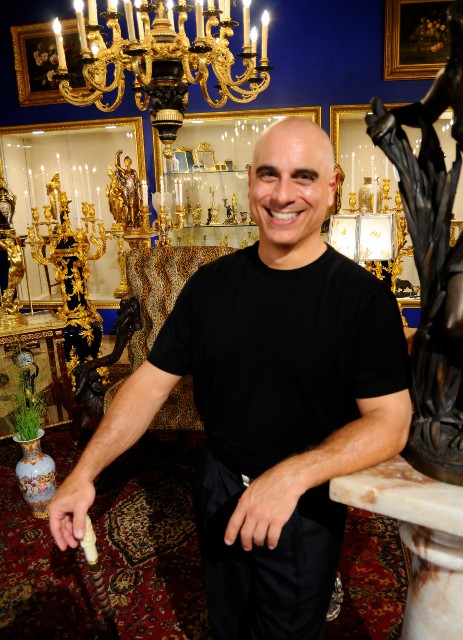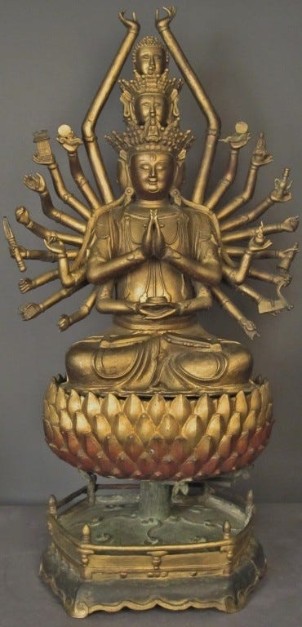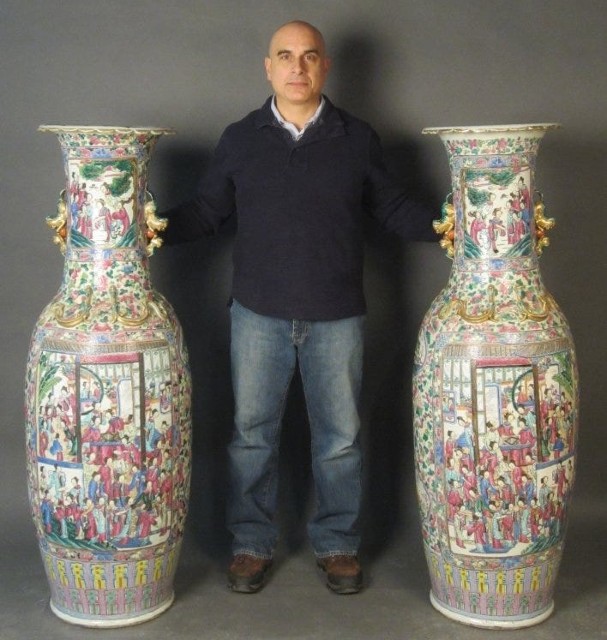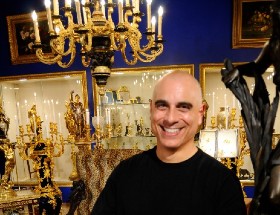
NORWOOD, N.J. – Stephen D’Atri, owner of Sterling Associates in Norwood, N.J., is a man on the move. He often spends hours in his office, researching items for sale. But at any moment, he’s likely to hit the road to make a house call to check out an interesting estate or collection or do a pickup. Stephen learned the ins and outs of the antiques trade as a youth working in his family’s business, which specialized in antique lighting. He now runs a full-service antique gallery, restoration facility and auction house.
While he is a generalist selling everything from Asian porcelain to artwork, coins and jewelry, D’Atri is especially knowledgeable about fine European and American antiques. He was one of the first auctioneers to incorporate Internet live bidding [through LiveAuctioneers] into his business model and to develop his “hybrid auctions” format, i.e., auctions that run online just like live events, but minus in-person bidding. After the auction has concluded, successful bidders can pick up their goods from Sterling’s facility or arrangements can be made for shipment of the goods anywhere in the world. When Sterling Associates adopted the hybrid method, it was revolutionary — even unorthodox. But as time went on, other auction houses realized it was an efficient way to run an auction business.
What made you decide to transition from a traditional antiques business to auctions? I left my family’s business about 35 years ago and started doing restoration work in my new company as well as selling general antiques and lighting. Then we started to specialize in European furniture, European lighting and European sculpture, along with the restoration. We started doing auctions around 13 years ago and noticed, as time passed, that the market was changing a little bit for us. I felt more and more that auctions were going to be my future. With more availability of merchandise, the only way to sell it all was really liquidation and auction.

Your hybrid auction format was groundbreaking. Why eliminate live audiences? I was also a buyer at auctions, so I was trying to figure out what I liked most about what the new technology had to offer. I wasn’t necessarily attending auctions; I was phone bidding. I would preview the auctions in person and if I couldn’t do it in person, auction houses would send me photographs. With the computer and online technology that was available, it was much easier to reach people that way. I know a lot of people who were buying, especially at that time period, who weren’t coming to look at the items in person. They were simply calling up or asking for an opinion on the merchandise. Why have an auction with 100 people or 50 people when a good 50 to 60 percent of them were buying on the computer or telephone anyway? So we took a chance and said we would accept phone bids, we would accept absentee bids and obviously computer bids. We didn’t feel there was a need to have that live audience because if you have good merchandise and you have things that people want to buy, they will still leave a bid or bid using a remote method. I don’t think they needed to physically be there.
Was this a hard sell or an easy transition? It was a little tough in the beginning. Some people were very resistant to it, but obviously, today so much is done online. There might not ever be live auctions again after the coronavirus, who knows?

How has your business most been affected by COVID-19? Honestly, the biggest part of COVID was getting the inventory. We do all local house calls, and in the very beginning of the pandemic it was a problem filling up an auction because folks were afraid to let you in the house … I would say that lasted through the summer for us, and then we got lucky. We got a couple of nice estates and now we are actually busy. It’s the new normal. It definitely put things on hold, and a lot of auctioneers have inventory for two to three auctions sitting in storage. We did not. We go from auction to auction. So basically, we didn’t have an auction from February to October. Now the way we’re going to do it is we’re going to have fewer auctions per year and consistently maintain a selection from the estates for our next auction. I am planning on having an auction in March, but instead of having a 300- or 400- lot auction, we will have a 200-lot auction and set aside the next 200 lots for the following auction.

You were one of the first auctioneers to really tap into the Chinese market and develop a following with bidders in Asia. Also, you’ve sourced some really fine Asian art from local estates and ended up selling them to Chinese buyers. How did you grow this market?
Just pure luck. We got a couple of estates that had some nice hidden gems in there, we publicized a lot of these items and started to get a following. If I look at my mailing list, we have a pretty large number of Chinese buyers. If you have the items they want and you’ve worked with them before, they’ll trust you. They like to see images, and we’re happy to send them whatever they want. Shipping overseas is not a problem, and if they are comfortable buying from you, you’ll keep them as customers. We got lucky and tapped into the market with some decent items that drew aggressive bidding, and we held onto those bidders. We value them very highly.

Describe a typical day for you.
These days it’s very boring – lots of research and photography – although I am on the road every day. If I were to get a phone call right now, I would put you on hold, and if it’s a client looking to sell something, I’d come back to you and say, “Gotta go.” My job is to get to the consignor as quickly as possible. If they are within an hour’s radius of me and they are home now, I will get in my car now and go. Other than that, I’m in the gallery and just moving stuff around — photographing it, researching it and getting it ready. That’s our typical day, but there is some variety to it. We are a small company, so I do everything. It’s never boring.
To contact Stephen D’Atri, call 201-768-1140 or email info@antiquenj.com. Sterling Associates is located in Bergen County, New Jersey, at 537 Broadway, Norwood, NJ 07648. Visit them online at http://www.antiquenj.com.
[av_button label=’Click to view Sterling Associates’ past auction catalogs’ icon_select=’no’ icon=’ue800′ font=’entypo-fontello’ link=’manually,https://www.liveauctioneers.com/auctioneer/1353/sterling-associates/’ link_target=’_blank’ size=’small’ position=’center’ label_display=” title_attr=” color_options=” color=’theme-color’ custom_bg=’#444444′ custom_font=’#ffffff’ btn_color_bg=’theme-color’ btn_custom_bg=’#444444′ btn_color_bg_hover=’theme-color-highlight’ btn_custom_bg_hover=’#444444′ btn_color_font=’theme-color’ btn_custom_font=’#ffffff’ id=” custom_class=” av_uid=’av-5stv7d6′ admin_preview_bg=”]


